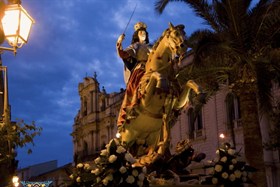The Feasts of Moors and Christians
 The Feast of Moors and Christians is a ritual that is shared by the southern regions of Italy and Spain, during the Early Modern period subject, as they were, to raids by ships of Barbary pirates from the nearby African coasts. Unlike the festivities that take place in the Italian Mezzogiorno, generally inspired by the famous Battle of LepantoWas a naval battle that took place on 7 October, 1571 and that pitted the Holy League (Spanish Monarchy, the Duchy of Savoy, the Papacy and the Republics of Venice and Genoa) against the Ottoman Empire. The victory put a stop to Ottoman expansion in the Christian West. (1571) or some “Turkish” or pirate raids, the ceremonies organized in the regions of south-eastern Spain (Murcia, Castile-La Mancha, the Valencian Community) mainly commemorate the Reconquista, the long process of “liberation” of the Iberian Peninsula from the Arab domination which lasted for several centuries (which culminated in 1492 with the capture of Granada and the early seventeenth century with the expulsion of the MoriscosThe term Moriscos was used to designate the descendants of the Moors, after the Christian Reconquista, that had formally agreed to repent and abandon Islam. In reality, the morisca population continued to maintain their traditional ways and to practice the Muslim religion in secret. From 1609 until 1614, on the orders of Philip III all the Moriscos, approximately 300,000 people, were expelled from the Iberian Peninsula.). They are true theatrical performances, which involve a large number of extras in costume who are assigned the task of embodying Moors and Christians and simulating ancient and mythical battles (which sometimes consist of a dance, a way of representing the encounter/clash with Muslim populations which is also found in the suggestive parade of the Giants). During these events, in addition to the use of protective clothing and weapons which are more or less in keeping with the historical periods referred to, there is often also the use of stage machinery of wood (castles and ships). Not infrequently we witness the staging of events and characters belonging to different eras (the Crusades and the Templars, for example), confused with each other in the name of a cheerful festive mix. (photo: the Madonna of the Milizie di Scicli “of the Militia of Scicli”, the protagonist of one of the most famous festivals of Moors and Christians in southern Italy).
The Feast of Moors and Christians is a ritual that is shared by the southern regions of Italy and Spain, during the Early Modern period subject, as they were, to raids by ships of Barbary pirates from the nearby African coasts. Unlike the festivities that take place in the Italian Mezzogiorno, generally inspired by the famous Battle of LepantoWas a naval battle that took place on 7 October, 1571 and that pitted the Holy League (Spanish Monarchy, the Duchy of Savoy, the Papacy and the Republics of Venice and Genoa) against the Ottoman Empire. The victory put a stop to Ottoman expansion in the Christian West. (1571) or some “Turkish” or pirate raids, the ceremonies organized in the regions of south-eastern Spain (Murcia, Castile-La Mancha, the Valencian Community) mainly commemorate the Reconquista, the long process of “liberation” of the Iberian Peninsula from the Arab domination which lasted for several centuries (which culminated in 1492 with the capture of Granada and the early seventeenth century with the expulsion of the MoriscosThe term Moriscos was used to designate the descendants of the Moors, after the Christian Reconquista, that had formally agreed to repent and abandon Islam. In reality, the morisca population continued to maintain their traditional ways and to practice the Muslim religion in secret. From 1609 until 1614, on the orders of Philip III all the Moriscos, approximately 300,000 people, were expelled from the Iberian Peninsula.). They are true theatrical performances, which involve a large number of extras in costume who are assigned the task of embodying Moors and Christians and simulating ancient and mythical battles (which sometimes consist of a dance, a way of representing the encounter/clash with Muslim populations which is also found in the suggestive parade of the Giants). During these events, in addition to the use of protective clothing and weapons which are more or less in keeping with the historical periods referred to, there is often also the use of stage machinery of wood (castles and ships). Not infrequently we witness the staging of events and characters belonging to different eras (the Crusades and the Templars, for example), confused with each other in the name of a cheerful festive mix. (photo: the Madonna of the Milizie di Scicli “of the Militia of Scicli”, the protagonist of one of the most famous festivals of Moors and Christians in southern Italy).
